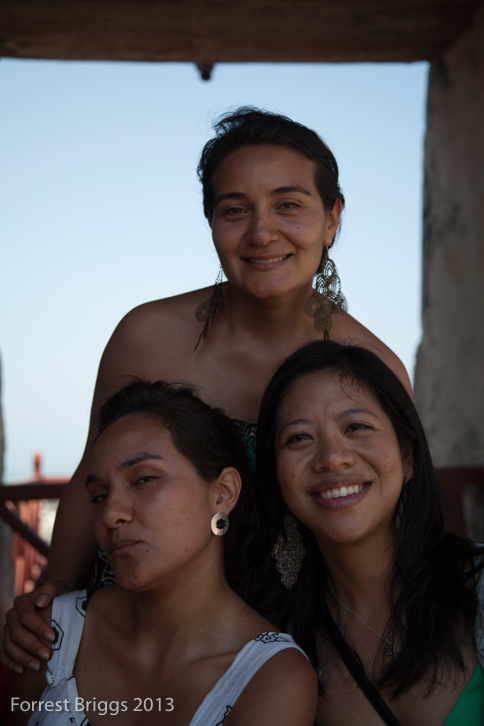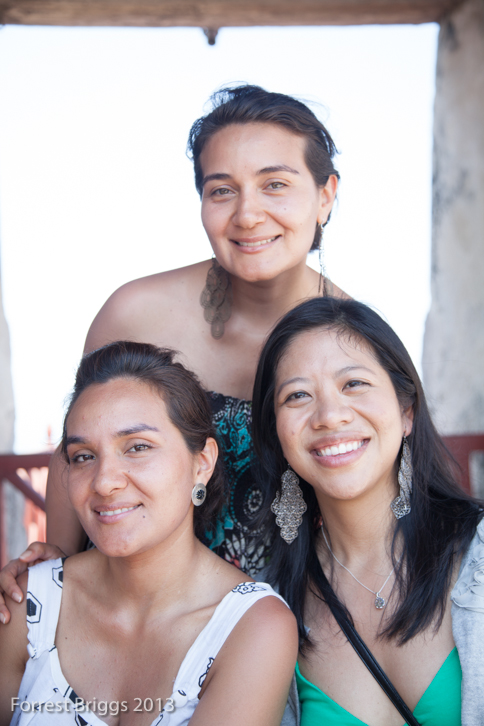So on a recent trip to Cartagena, Colombia I was fortunate enough to play paparazzi for my lovely hosts Mary and Tephy. While visiting the Castillo San Felipe de Barajas (Castle named after King Philip of Spain, where a few scenes from Romancing the Stone allegedly took place), I wanted to knock out two birds with one stone – capture a few images of my hospitable hosts and illustrate the difference between Spot metering and Evaluative metering (Gosh, isn’t metering at the forefront of all of our minds while decompressing on vacation). This post will reinforce the idea that a few different types of metering can be used in conjunction with the camera’s aperture and shutter speed to render a correctly exposed portrait (or whatever else we choose to capture through our camera’s viewfinder). First, let’s briefly examine an extremely simplified understanding of metering:
In photography, to render a correctly exposed image (“correct” = middle gray…not too dark and not too bright, but 18% gray), digital cameras are equipped with light meters. Our camera’s light meter is a device that merely evaluates how intensely light reflects off objects we see through our DLSR camera’s viewfinder (yes, believe it or not, reflectance shapes and defines the world around us. If objects didn’t reflect any light, we’d rely on braille, canes and/or sonar every waking moment of the day).
A meter is a fairly simple concept to understand. Most of us use them every day while driving to work or running errands. Each time we glance down at our dashboard to verify our current velocity, we are using our car’s built in meter (speedometer, in this case). On the interstate highway, if our speed exceeds 65 mph, we get penalized via a soft-spoken gentleman wearing aviators and a wide-brimmed hat. If our speed falls below 65 mph, we get penalized via honking horns and funny hand gestures. In short, our car’s speedometer is a visual display that helps us avoid suffering unwanted consequences. In a similar vein, our camera’s light meter is a display that also prevents us from suffering unwanted consequences. If too much light is reflected off of our subject and hits the camera’s sensor, we run the risk of our photos being overexposed. If too little light hits the sensor, our photos will be underexposed. In either photographic situation, our camera’s built-in light meter indicates whether or not we have a correct exposure (although this point is somewhat debatable… more in a later post). If our light meter indicates that our scene is too bright or too dark, we can adjust our aperture and / or shutter speed until the optimal amount of light hits our sensor (similar to driving too fast / slow on the Interstate, we can let up / press the accelerator until we are traveling at the correct speed).
So now that we’ve touched on what a camera’s light meter is and what it is used for, we can delve deeper into this crucial element of photography and examine a couple of different types of metering (yes iPhone users, as difficult it is to fathom, photography is infinitely more complex than merely tapping the ‘shutter’ icon on your phone). While most digital cameras house an array of different metering options, for simplicity sake, we’ll boil this discussion down to two options – evaluative metering (that’s Matrix metering for the Nikonites out there) and spot metering.
Evaluative metering – Your camera uses the entire sensor to render a correctly exposed photo. Basically everything you see through the viewfinder is taken into account to determine a proper, “middle grey” exposure.
Spot metering – Anything within a small portion of the sensor (an area of about 3% of the sensor) is correctly exposed. The brightness / darkness of the data lying outside out that 3% is adjusted accordingly.
Why on earth would we want to correctly expose only 3% of our image? Well, say for example we want a correctly exposed portrait, however the subject is backlit (the preponderance of light originating from behind the subject). By spot metering on the subject, we can ensure that the subject is correctly exposed. Note, I said the subject, and not the entire photo. The background may become washed-out if a high amount of contrast exists between our subject and the bright background.
So which should we use – Evaluative Metering or Spot Metering? The answer is ‘it depends’. Is there a small subject in our field of view that we want correctly exposed, or do we want an average tonal value applied across the entire photograph? Its a judgement call which ultimately depends upon the photographer’s creative tastes.
Perhaps the impromptu portraits below will aid in understanding this concept.


In the portrait on the left, I focussed on my lovely models using Evaluative metering. The entire sensor was used to provide the correct aperture / shutter speed combination to produce a portrait that had an average reflectance of 18% across the entire photograph. Note the sky in the background is blue, however Mary’s, Tephy’s and Melissa’s headshots are a bit underexposed (dark).
In the portrait on the right, the correct aperture / shutter speed combination was determined by metering only on Mary’s face (the woman in the middle), not the entire frame. Thus assuming that Mary’s face has a reflectance of 18%, it is now correctly exposed. The rest of the scene is slightly overexposed (note the washed-out sky in the background). If we had underexposed Mary’s face, the entire scene would be darker. If we had overexposed Mary’s face, the entire scene would be even brighter. I used spot metering in this photo as I wanted to make sure that my friend’s headshots were correctly exposed and I did not care how the sky and the castle walls in the background looked. As mentioned previously, spot metering is useful for correctly rendering a subject in which a high amount of contrast (brightness vs darkness) exists in the image (in this case, the background was substantially brighter than mi amigas).
So we touched on metering, evaluative metering and spot metering, as well as when one type of metering is superior to the other (an understanding for each of the above is critical for producing good headshots / portrait photos). Note, a few caveats and assumptions exist with the above post, but we will save those for future entries. Additionally, while our camera meters are calibrated to luminescence of light reflected from objects with a middle gray tone (18% gray to be precise), in the real world, skintones, trees, buildings, etc rarely reflect this exact value (e.g., caucasian skin is about 1 stop lighter than middle grey). Thus to ensure that we expose a subject correctly, it is critical for serious photographers to use a gray card in conjuction with their camera’s light meters. More on this in a later post. For now, just understand that we use our meters to select the correct shutter speed / aperture combination in order to produce a correctly exposed headshot.
